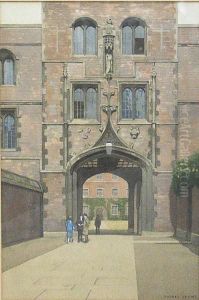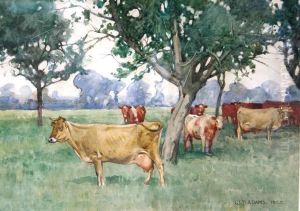William Dacre Adams Paintings
William Dacre Adams was an English artist born in the mid-19th century, a period marked by significant changes in art and society. Born in 1864, Adams lived through the transformative years of the Victorian era and into the early 20th century, witnessing the evolution of art from romanticism to modernism. Despite the considerable shifts in artistic styles and preferences during his lifetime, Adams managed to carve out a unique niche for himself in the art world, primarily focusing on landscape and portrait painting.
Adams' upbringing and education played a crucial role in shaping his artistic sensibilities. Coming from a family that valued culture and the arts, he had access to a wealth of artistic resources from a young age. He pursued formal art education at prestigious institutions, which was quite typical for artists of his era, seeking to refine his skills and techniques. His education not only provided him with technical skills but also exposed him to a variety of artistic styles and movements.
Throughout his career, Adams exhibited a profound appreciation for the natural world, which became a recurrent theme in his landscape paintings. His landscapes were known for their serene beauty, meticulous detail, and ability to capture the changing moods of nature. Adams' landscapes did not just replicate the physical appearance of a location but also aimed to evoke the emotional and atmospheric qualities of the scene. This approach allowed viewers to connect with his work on a deeper level, making his paintings highly appreciated during his time.
In addition to landscapes, Adams also gained recognition for his portrait paintings. He had a keen eye for capturing the essence and personality of his subjects, which made his portraits highly sought after by the elite of society. His ability to depict the subtleties of expression and character in his portraits set him apart from many of his contemporaries.
Adams' contributions to the art world were not limited to his paintings. He was also an active member of the artistic community, participating in exhibitions and engaging in discussions that helped shape the direction of British art in the late 19th and early 20th centuries. Despite the changing artistic trends over the decades, Adams remained true to his artistic vision, focusing on the beauty of the natural world and the depth of human expression.
William Dacre Adams passed away in 1951, leaving behind a legacy that continues to be celebrated for its contribution to British art. His work remains a testament to the enduring appeal of landscape and portrait painting, and his dedication to his craft serves as an inspiration for future generations of artists.




